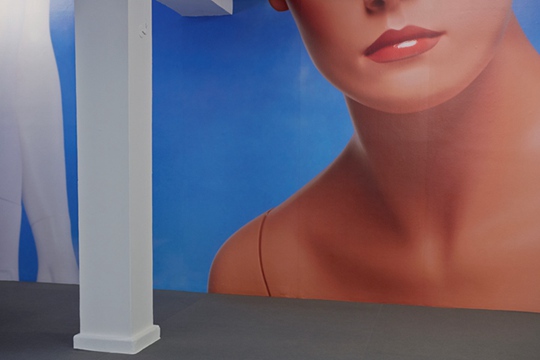IMAGINED NETWORKS
| July 7, 2015 | Post In 2015年6月号

Courtesy the artist
PHOTO: Theo Cook
Kim Kardashian shot a nude cover for the independent New York magazine Paper’s winter issue; reader reaction to the photo itself was dominated by questions of Photoshop. Today, anything modified in post-production cannot be considered truly nude. Popular culture’s visual machine continues to churn out the perfect image: an ad for a breakfast cereal immersed in creamy whole milk, a perfectly proportioned model in a fashion magazine, even though everyone has caught onto the tricks behind perfection (the milk in those photos is really glue). The consuming public sees the chasm between media perfection and reality, but it does not stop us from yearning for that virtual perfection. A Japanese company promotes a foundation make-up offering “CG Texture”; nobody believes that wiping her face with two pads will give her the skin of Lightning from the Final Fantasy franchise. In the course of the evolution of beauty, geographies with frequent cultural exchange have tended to share similar concepts. East Asian countries once preferred fair skin, copious amounts of rouge and powder, and teeth stained black. Today, the Korean face has taken Asia by storm: big eyes, thick brows, double eyelids, unnaturally straight but petite noses, fair-as-snow white skin, and a sharp chin, all on a small face with narrow cheekbones that suggest Japanese anime rather than reality. Excessively similar idols sharing nearly identical facial features are often the fruit of massive surgery or Photoshopping. If the old normal for the cosmetic industry was to improve one’s figure, the new normal is to exchange one face for another, to abandon the face as an absolutely unique identifier and swap it for a familiarity bred from more than genetics, all in order to form a tightly knit group identified by their similar looks—a global imagined network, as scholar Wendy Chun might call it, that has evolved away from local imagined communities. Such population groups supercede cultural and national barriers to create a new fictional race that rules over anywhere images are in circulation.

Courtesy the artist
PHOTO: Theo Cook
Text by Venus Lau
Translated by Frank Qian

